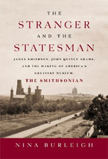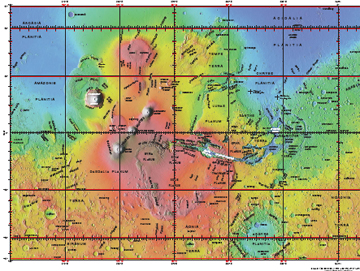
The Stranger and the Statesman: James
Smithson, John Quincy Adams, and the Making of America’s Greatest
Museum
by Nina Burleigh. HarperCollins, 2003. ISBN 0 06 000241 7.
Hardcover, $24.95.

Check out this month's On
the Web links, your connection to earth science friendly Web sites. The
popular Geomedia feature now available by topic.
Book Reviews:
The Foreign Founder of the Smithsonian
Maps:
Global Mars maps
 |
The Stranger and the Statesman: James
Smithson, John Quincy Adams, and the Making of America’s Greatest
Museum
|
Most of us employed at Smithsonian have the vague knowledge that James Smithson’s
disenchantment with British aristocracy was behind his curious bequest to create
an institution to be founded in Washington, D.C., “for the increase and
diffusion of knowledge among men.” But this is far from the complete story.
Thanks to this lively and extraordinarily well-researched book, Nina Burleigh
shows the situation to have been far more interesting and complex.
Smithson, one of several bastard children of the immensely wealthy Duke of Northumberland,
was born in 1765 and raised in Paris. His given name wasn’t even Smithson
— it was Jacques Macie, the name given to him by his then unwed mother,
Elizabeth Macie. It wasn’t until he was nine years old that his mother
took him to London to grow up as a proper Englishman; Elizabeth Macie then arranged
for the passage of a parliamentary bill that naturalized him James Macie.
James Macie received a proper English schooling and entered Pembroke College
(Oxford) in 1782. At Oxford, he was a superb student, particularly excelling
in chemistry. It was there that he learned the technique of blowpipe analysis,
perfected earlier in Sweden, to analyze minerals and other materials.
Macie, although he was not doing what we would now call cutting-edge science,
was noted for his persistence in obtaining accurate analyses; he sometimes repeated
individual measurements 100 or 200 times to obtain the results he sought. This
fine work caught the eye of eminent scientists of the day, and he attracted
the support of luminaries such as James Hutton and Henry Cavendish. This, plus
the unspoken knowledge of his aristocratic (albeit “irregular”) birth,
led to his election to the Royal Society at the age of 22, then the youngest
person to join that elite organization.
In the early 1790s, Macie’s predilection for foreign residency took hold,
and he moved back to Paris. As the French Revolution heated up, he moved to
Italy and then to Germany. But upon the death of his mother in 1800, he quickly
returned to London. Following her request that his name should reflect his true
heritage, James Macie changed his name to James Smithson, the family name of
his father, the late Duke of Northumberland (né Hugh Smithson). He also
inherited his mother’s considerable wealth, consisting mostly of lands
and properties that brought him a handsome income.
So we learn that Smithson’s wealth came not from the father’s side
of this nonexistent family but from his mother, who tenaciously held and further
accumulated land and property inherited from her family. One might argue that
the Smithsonian Institution should more appropriately be called the Macieian
Institution!
Gradually, Smithson became disenchanted with the Royal Society, perhaps because
its then-younger members looked down on his repetitive and less-than-original
research. He then shifted his allegiance to the Royal Institution, newly established
by a group of wealthy English gentlemen to bring knowledge to the general public.
This event provides a hint about Smithson’s later interest in diffusing
knowledge to the public.
Smithson continued with his blowpipe work into the 1820s, but his health was
failing. He gambled a great deal toward the end of his life, so much so that
a good friend (named Arago) had to intervene to prevent Smithson from frittering
his fortune away. Later Arago joked that without his help, the Smithsonian Institution
might never have been founded. Smithson died in 1829, leaving his estate to
the U.S. government; he was buried in Genoa, Italy.
What kind of man was James Smithson? Burleigh portrays him as reticent, noting
he was never married. Furthermore, Burleigh reports there’s no record that
he ever had romantic relationships of any sort. So how could such an introverted
and seemingly conservative man be so radical as to will his fortune to the United
States — a place he had never visited? Amazingly, there’s no evidence
that he had ever even met an American.
Burleigh, like previous historians, cannot solve the Smithson mystery completely,
but she brings us closer to the answer. She further develops the widely held
belief that Smithson deeply resented the fact that his irregular birth precluded
his acceptance by aristocratic English society. He desperately wanted a title,
but this was denied him. His gradual disenchantment with (and rejection by)
the Royal Society and his embrace of the now-vanished Royal Institution (with
its goal to spread knowledge to the general public) widened the distance between
him and the stodgy establishment. Smithson also wanted a kind of revenge for
what he felt the system had done to him, and the following remark from his copious
unpublished notes states this very clearly: “My name shall live in the
memory of man when the titles of the Northumberlands ... are extinct and forgotten.”
But this is only half the story. Burleigh goes on to tell how the 105 sacks
of gold were brought to the United States, and how Southern congressmen, defending
states rights and rabidly opposing any initiatives by the central government,
did everything in their power to scuttle the lofty wishes of James Smithson.
As a result of some unbelievable shenanigans, most of the money was invested
in Arkansas state bonds. It took the hard work of statesman John Quincy Adams
(the “Statesman” of the book’s title) to have an equal amount
of money appropriated by Congress to fulfill Smithson’s intentions. Others
in Congress also worked long and hard to bring the Smithsonian Institution to
reality.
Although not dealt with in The Stranger and the Statesman, it is interesting
to consider how the earth sciences have been impacted by James Smithson’s
institution since its founding in 1846. The National Museum of Natural History
(NMNH), where most of the institution’s geological research takes place,
has certainly contributed much to the “increase and diffusion of knowledge”
through its collections of objects.
The museum’s rich holdings in the fields of paleontology, mineralogy, meteoritics
and volcanology have not only facilitated the research of Smithsonian scientists,
but also the work of thousands of other researchers, here and abroad. It can
be said that James Smithson’s bequest has had an enormous positive impact
on collections-based earth science research around the world.
A far broader impact has been the diffusion of knowledge to the general public.
Since 1960, an average of 5 million people have visited NMNH each year (that’s
a total of 220 million people), and millions more came in earlier years. Surely,
just about all of these people paid visits to the exhibit halls featuring the
geosciences. Collectively, these visitations represent the diffusion of earth-science
knowledge on a scale far beyond Smithson’s imagination.
Burleigh deserves high praise for researching and bringing together so much
information on Smithson in The Stranger and the Statesman. You don’t
have to be a Smithsonian employee to be captivated by this informative and well-written
book.
 A new set of
maps of Mars may help you get your geographic bearings as you pour over new
images sent back to Earth from the twin rovers on the Red Planet. The two-sheet
set consists of a topographic map and a color-coded contour map of the martian
surface. The set shows the landing sites of the rovers as well as the landing
sites from the previous Viking and Pathfinder missions.
A new set of
maps of Mars may help you get your geographic bearings as you pour over new
images sent back to Earth from the twin rovers on the Red Planet. The two-sheet
set consists of a topographic map and a color-coded contour map of the martian
surface. The set shows the landing sites of the rovers as well as the landing
sites from the previous Viking and Pathfinder missions.
“The maps may give people more of a feel for Mars being a place that one
could imagine going to, not just a dot in the sky,” says Randy Kirk of
the U.S. Geological Survey (USGS). They show, he says, a wide range of landforms,
some of them relatively unfamiliar (such as craters) and some more familiar
(such as the channels cut by water sometime in the past). “The maps also
show that there’s no water on the surface now,” Kirk says, “so
in that sense they’re a good introduction to the burning question about
Mars: What happened to its climate?”
Prepared for NASA by USGS, the map set comes from data off the Mars Orbiter
Laser Altimeter, an instrument on NASA’s Mars Global Surveyor spacecraft.
The base image represents more than 6 billion measurements gathered between
1999 and 2001. “These maps are one to two orders of magnitude more accurate
than earlier martian maps,” says Ken Tanaka, also at USGS. He notes that
these are also the first USGS global Mars maps available in both print and electronic
form.
Each map measures 36 by 32 inches. The set is available for $14 through USGS
Earth Science Information Centers. Call 1-888-ASK-USGS or visit their stores
online.
 |
Geotimes Home | AGI Home | Information Services | Geoscience Education | Public Policy | Programs | Publications | Careers |